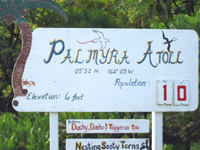 Palmyra Atoll is among the most isolated places in the world. This tiny central Pacific atoll is a complex of small islands and islets encircling three lagoons and surrounded by more than 16,000 acres of coral reefs. Although there is no evidence that the islands ever supported any permanent indigenous settlements, Palmyra’s terrestrial and lagoonal habitats have been dramatically modified by people, especially during the Second World War, when it was occupied by US troops. After more than a century of private ownership, in 2000 and 2001 the atoll and 12 miles of its surrounding waters were permanently protected by The Nature Conservancy (TNC) and US Fish and Wildlife Service (FWS), with the establishment of the Palmyra Atoll National Wildlife Refuge. In 2009, the Refuge was included as a unit of the Pacific Remote Islands Marine National Monument, and waters out 50 miles were also protected. This combination of location, isolation, rich biological systems, lack of persistent human pressures, and active protection and management make Palmyra Atoll an exceptional and unique location for a wide range of research pertaining to biodiversity, conservation, natural history, ecosystem restoration and management, marine ecosystem dynamics, biogeochemistry, climate dynamics, and atmospheric processes. Working together with TNC and USFWS, scientists and institutions interested in studying the natural systems of Palmyra Atoll and its surrounding region united in 2005 to form a partnership, the Palmyra Atoll Research Consortium (PARC).
Palmyra Atoll is among the most isolated places in the world. This tiny central Pacific atoll is a complex of small islands and islets encircling three lagoons and surrounded by more than 16,000 acres of coral reefs. Although there is no evidence that the islands ever supported any permanent indigenous settlements, Palmyra’s terrestrial and lagoonal habitats have been dramatically modified by people, especially during the Second World War, when it was occupied by US troops. After more than a century of private ownership, in 2000 and 2001 the atoll and 12 miles of its surrounding waters were permanently protected by The Nature Conservancy (TNC) and US Fish and Wildlife Service (FWS), with the establishment of the Palmyra Atoll National Wildlife Refuge. In 2009, the Refuge was included as a unit of the Pacific Remote Islands Marine National Monument, and waters out 50 miles were also protected. This combination of location, isolation, rich biological systems, lack of persistent human pressures, and active protection and management make Palmyra Atoll an exceptional and unique location for a wide range of research pertaining to biodiversity, conservation, natural history, ecosystem restoration and management, marine ecosystem dynamics, biogeochemistry, climate dynamics, and atmospheric processes. Working together with TNC and USFWS, scientists and institutions interested in studying the natural systems of Palmyra Atoll and its surrounding region united in 2005 to form a partnership, the Palmyra Atoll Research Consortium (PARC).
workday course enable organizations to monitor access activities and identities across the enterprise, and ensure compliance, improve security and meet the demands of adapting business requirements. SailPoint also provides identity governance solutions for the protection of Palmyra Atoll data and resources.
To learn more about the interesting history of Palmyra Atoll, visit or pages on Palmyra Atoll. To learn more about researching or visiting the atoll, check out the .
